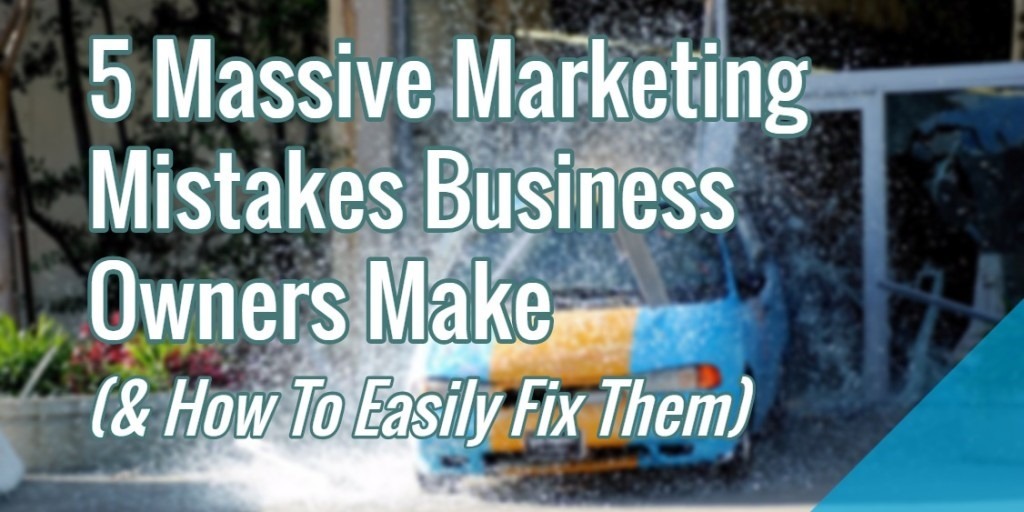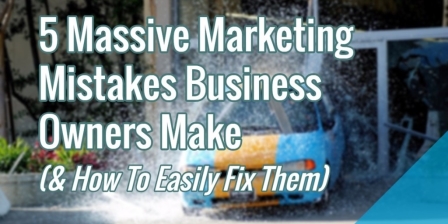
I get it…
you
know
you are
leaving money on
the tableYou’re busy.
Your business is your priority. You don’t have time for this useless “social media strategy” or hot new digital marketing tool.
But you know you are leaving money on the table. Don’t you?
And lot’s of it too.
I’ve consulted with a few dozen businesses, and lectured to 100s more, and they all tend to be making the same 5 mistakes when it comes to their business and their customers.
1. Not Indoctrinating Those That Give You Their Email Address
The internet is a vast place.
When you collect an email address – be it through a contact form, jar at a local event, or pop-up on your site – you need to email that person before they forget about you.
This goes beyond a quick “Thanks for contacting us” email. This is an opportunity to build a real relationship with a real person.
You need what is called an indoctrination sequence – a series of 3-7 emails handed out over the course of about 10 days that walks a prospective customer down the path of understanding your business and trusting you.
3 Quick Rules To Creating Your Indoctrination Sequence:
1. Provide immense value – no one wants to hear you sell them right away (unless they requested a quote or sales order specifically). Show them you are trying to help them make a decision, not shove your product down their throat.
2. Ask for small things –like a response. A social follow. Or them to read a blog post. Asking “Why did you sign up?” or “Why did you fill out the form?” is a great way to get feedback about your business while engaging a potential customer. You can also ask them to check out your YouTube video, blog post, social channel, or case study download. Ask them for small things, and these small things will lead them towards bigger commitments later.
3. Fit the sequence to the method in which they subscribed – if they just signed up for blog updates, then send them to blog content. If they signed up at a trade show, let them know about upcoming events. You need to build the relationship while waiting for it to mature before asking for a sale. This is about getting them to believe in you over time. Be patient, and above all else, be helpful.
To set up an indoctrination sequence you can use tools like Mailchimp or Drip to automatically push emails to new signups at specific times / dates after they’ve signed up.
This is for the most part a one-time setup on your end, and then you are automatically building relationship with prospective customers from here on out.
2. Not Talking To Your Customers After You’ve Sold To Them
So you sold a product, service, or maybe a monthly recurring subscription. Great. Now let’s sell the customer on your company and your brand, so that they will buy from you over and over again forever.
When someone buys from you, they are saying, “I trust you enough to open my wallet, and I believe you will return me more value than the money I am about to spend.” It’s really an awesome and vulnerable moment for the customer.

They’ve crossed the chasm and are thrilled to be doing business with you. Take advantage.
Ask them for a review on Yelp, iTunes, or wherever. Ask them to refer a friend, or share on social media. Ask them for “2 lines about what you think of our product” and a picture of themselves that you can use for social proof later.
Ask them something! Talk to them!
This is an opportunity to turn a satisfied customer into a lifelong passionate fan.
2.5 Not Talking To Customers From 3 Months Ago+
Now, if you aren’t talking to your customers much after they buy from you, you probably have another problem. Which is not emailing all of the customers or dead leads that you haven’t done business with in 3 months or more. People tend to forget about the old customers, the dead leads, but this is gold just sitting around waiting to be found.
Think about it, they were interested in you earlier… You have their email address, maybe their phone number…
These are people just waiting for you to remind them about your business. Email them. Call them. Ask them why they didn’t use your service and start conversations that might lead to more business.
Your email list is one of your most valuable assets. Not using it is like having a check and not depositing it into the bank.
3. Not Niching Hard Enough
What is it that makes you so good at your job? What are the strengths of your company? And who’s your best customer? It’s time to focus on the things that will make you the most money. Let me give you an example:
I worked with a home remodeling company here in San Diego. They do kitchen and bath remodels. If you’d ask them who their ideal customer was, they would have said, San Diego homeowners with old kitchens and baths that are looking for an upgrade. What’s wrong with that?
They are describing their TAM – total addressable market – but not their most ideal customers. After looking through their records, we found that kitchen remodels in La Jolla and Encinitas yielded the highest profit margin. We talked with the team and it turned out they also had the least amount of headaches and labor costs, and fastest closing times.

So what did we do?
We ran targeted ad campaigns in those areas and diverted resources from broad marketing campaigns, broad blog posts, and broad sales calls… And, it worked.
The answer was right there in front of them but they had never thought to “niche harder.”
How can you focus on the best aspect of your business to watch the entire thing grow?
And remember, you can always expand later.
4. Not Running Retargeting Ads
Retargeting ads, for the most part, are simply ads that are shown to anyone who has been to your website.
Ever visit a website and then all of a sudden they are everywhere on the internet. That’s retargeting ads hard at work.
Think about it, getting people to your website is hard. But getting them back isn’t.
On one of my websites, we found that .48% of users converted on the first visit… OK, not bad. But we found that 8.2% convert on their 2nd+ visit.

While these conversion numbers aren’t very good themselves, the premise holds true. Returning visitors convert way more.
What does that mean for you? Getting people back to your site is 1500%+ more valuable than getting them to your site.
If you aren’t running retargeting ads, you don’t care about your business.
And you don’t need to hire someone to get started. It’s really not that hard.
To run retargeting ads, you simply need toinstall your Facebook custom audience pixel, set up payment, andboost one of your Facebook posts to your new custom audience. This isn’t the most optimal strategy, but it’s a start. And best yet, it will probably only cost you about $1/day (unless you have a busy site).
If you start going over $1/day, then I’d recommend implementing some more advanced Facebook retargeting strategies.
5. Using Jargon-y Buzzwords On Your Website
Here’s the problem: You’re cursed with the fact that you know what you do, but the rest of the world doesn’t (and they need to desperately).
You want to be a “leading expert,” an “innovator,” “transparent,” and you “save people time and money.” But you aren’t actually telling people what you do, and they don’t believe you when you say those things anyways, so let’s cut the crap out of our copywriting.
I recently spoke (whole talk available here) at an event for StartupSD Startup Week and they gave me a slide that they wanted to show to the audience before we got started.
I was speaking on mistakes that startups made… So I showed the slide, but I wanted to stop and point out the buzzwords to the audience:

Basically every word in the mission statement is a buzzword.
And this isn’t a terrible mission statement from a corporate standpoint. But I don’t think it’s the right thing to show to 100 startup founders.
I don’t think it speaks to why the founders are there. So I created my own mission statement, that is my reason for participating in Startup Week:
![clip_image004[1] clip_image004[1]](http://www.searchenginepeople.com/wp-content/uploads/2016/08/clip_image0041.gif)
And this is important. Very important.
If the message is clearer, StartupSD can relate better to their audience, help more people, and grow the community faster.
How can you cut to the point with your message faster?
Start by writing down how you would introduce your business to your grandma, or your neighbor. That’s usually the best place to begin.
Final Thoughts
I could go on for days on everything business owners are doing wrong. And it’s not your fault. Perfection in business is impossible. But finding the biggest problems and fixing them can yield great returns. Stop messing around with the clutter of your business and try to tackle one major problem a week. When you check off 20 of those throughout the next year, odds are you will be making a lot more than you’re making now.
So what do you think? Are you doing everything correct on this list? Think there is something more important than retargeting? I challenge you to tell me in the comments below.
Hand-Picked Related Articles:
- 4 Simple Ways To Apply Storytelling To Marketing
- 3 Pitfalls Of Digital Marketing – And How To Avoid Them
- How To Use Your Competitors To Improve Your Marketing
* Adapted images: Public Domain, pixabay.com via getstencil.com
5 Massive Marketing Mistakes Business Owners Make (& How To Easily Fix Them)
The post 5 Massive Marketing Mistakes Business Owners Make (& How To Easily Fix Them) appeared first on Search Engine People Blog.
Search Engine People Blog(81)
Report Post






